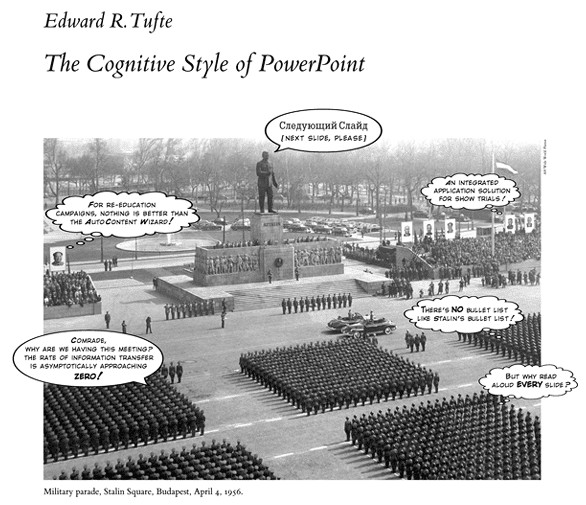The Cognitive Style of Power Point |

|
 Diese Seite wurde seit 6 Jahren inhaltlich nicht mehr aktualisiert.
Unter Umständen ist sie nicht mehr aktuell.
Diese Seite wurde seit 6 Jahren inhaltlich nicht mehr aktualisiert.
Unter Umständen ist sie nicht mehr aktuell.
 Zusammenfassungen
Zusammenfassungen
 In corporate and government bureaucracies, the standard method for making a presentation is to talk about a list of points organized onto slides projected up on the wall. For many years, overhead projectors lit up transparencies, and slide projectors showed high-resolution 35mm slides. Now "slideware" computer programs for presentations are nearly everywhere. Early in the 21st century, several hundred million copies of Microsoft PowerPoint were turning out trillions of slides each year.
In corporate and government bureaucracies, the standard method for making a presentation is to talk about a list of points organized onto slides projected up on the wall. For many years, overhead projectors lit up transparencies, and slide projectors showed high-resolution 35mm slides. Now "slideware" computer programs for presentations are nearly everywhere. Early in the 21st century, several hundred million copies of Microsoft PowerPoint were turning out trillions of slides each year. Alas, slideware often reduces the analytical quality of presentations. In particular, the popular PowerPoint templates (ready-made designs) usually weaken verbal and spatial reasoning, and almost always corrupt statistical analysis. What is the problem with PowerPoint? And how can we improve our presentations?
 Dieses Buch erwähnt ...
Dieses Buch erwähnt ...
 Fragen KB IB clear | Wie mache ich eine erfolgreiche Präsentation? |
 Begriffe KB IB clear |  PowerPoint PowerPoint
|
 Zitationsgraph
Zitationsgraph
 Zitationsgraph (Beta-Test mit vis.js)
Zitationsgraph (Beta-Test mit vis.js)
 Zeitleiste
Zeitleiste
 12 Erwähnungen
12 Erwähnungen 
- Powerpoint regiert (Guido Mingels) (2004)
- Einführung in das systemische Wissensmanagement (Helmut Willke) (2004)

- Vorsicht Bildschirm! - Elektronische Medien, Gehirnentwicklung, Gesundheit und Gesellschaft (Manfred Spitzer) (2005)


- Automated Use of a Wiki for Collaborative Lecture Notes (Melissa E. O'Neill) (2005)


- IT im schulischen Kontext - Medienpädagogik 2/05 (Heinz Moser, Heidi Schelhowe) (2006)
- Kopiertes Wissen - Das Verschwinden der Bildung im Zeitalter von Copy & Paste (Thorsten Lorenz)


- Kopiertes Wissen - Das Verschwinden der Bildung im Zeitalter von Copy & Paste (Thorsten Lorenz)
- Collaborative blended learning - Eine Orientierung für Lehrende, ModeratorInnen und TutorInnen zum Thema: Wie kann ich das E-Medium für Lernprozesse in der Erwachsenenbildung nutzen? (Barbara Buchegger, Lotte Krisper-Ullyett, Julia Michl, Johann Ortner) (2006)

- Informal Learning - Rediscovering the Natural Pathways That Inspire Innovation and Performance (Jay Cross) (2006)


- Report on dangers and opportunities posed by large search engines, particularly Google (Hermann Maurer, Tilo Balke, Frank Kappe, Narayanan Kulathuramaiyer, Stefan Weber, Bilal Zaka) (2007)


- Veränderungen wissenschaftlicher Literalität durch digitale Medien - Neue literale Praktiken im Kontext Hochschule (Anne Thillosen) (2008)


- Wiki Writing - Collaborative Learning in the College Classroom (Matthew Barton, Robert Cummings) (2009)


- Wiki Justice, Social Ergonomics, and Ethical Collaborations (Jonah Bossewitch, John Frankfurt, Alexander Sherman, Robin D. G. Kelley)

- Wiki Justice, Social Ergonomics, and Ethical Collaborations (Jonah Bossewitch, John Frankfurt, Alexander Sherman, Robin D. G. Kelley)
- PowerPoint - Macht und Einfluss eines Präsentationsprogramms (Wolfgang Coy, Claus Pias) (2009)

- electronic overheads - Elemente einer Vorgeschichte von PowerPoint (Claus Pias)
- Reclaiming Conversation - The Power of Talk in a Digital Age (Sherry Turkle) (2015)

 Volltext dieses Dokuments
Volltext dieses Dokuments
 Bibliographisches
Bibliographisches 
 Beat und dieses Buch
Beat und dieses Buch
Beat war Co-Leiter des ICT-Kompetenzzentrums TOP während er dieses Buch ins Biblionetz aufgenommen hat. Die bisher letzte Bearbeitung erfolgte während seiner Zeit am Institut für Medien und Schule. Beat besitzt kein physisches, aber ein digitales Exemplar. (das er aber aus Urheberrechtsgründen nicht einfach weitergeben darf). Aufgrund der wenigen Einträge im Biblionetz scheint er es nicht wirklich gelesen zu haben.









 , 8327 kByte)
, 8327 kByte) 



 Biblionetz-History
Biblionetz-History